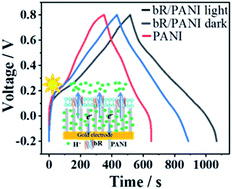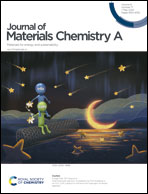Oriented bacteriorhodopsin/polyaniline hybrid bio-nanofilms as photo-assisted electrodes for high performance supercapacitors†
Abstract
Bacteriorhodopsin (bR), a proton-pumping protein that converts light into electrochemical energy, has recently attracted attention for solar energy conversion applications. However, its application for electrochemical supercapacitors has not been reported due to the demanding requirements on ordered oriented membranes. Herein, the authors explore bR for supercapacitor application by decorating oriented bR-monolayers onto the surface of an ordered and highly capacitive polyaniline (PANI)-nanofilm prepared by electropolymerization on an Au electrode. The prepared PANI-nanofilm displays good and tunable pseudocapacitive performance attributed to its multiple proton doping states. Due to the synergistic contribution of light-induced proton pumping capacity and the photoelectric function of bR, the specific capacitance of the bR/PANI/Au-electrode has been enhanced pronouncedly by the introduction of oriented bR-monolayers, and has been further improved upon light irradiation. At a current density of 60 A g−1, a specific capacitance as high as 1146 F g−1 was achieved following 550 nm light irradiation for the as-prepared bR/PANI-nanocomposites.



 Please wait while we load your content...
Please wait while we load your content...